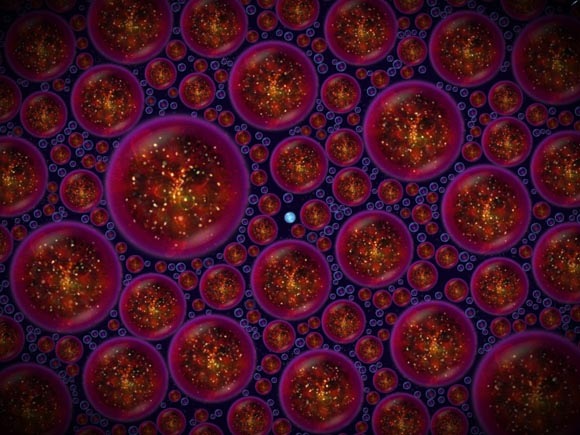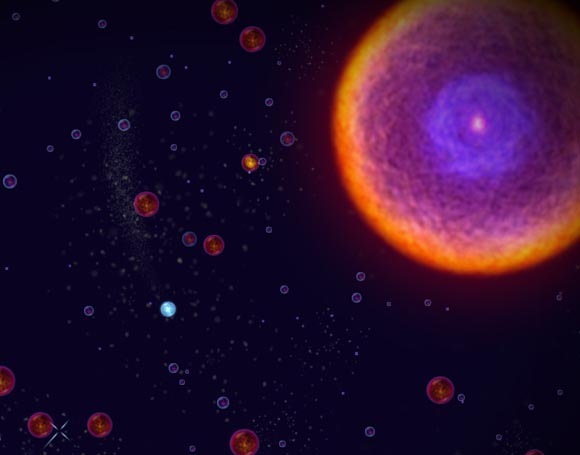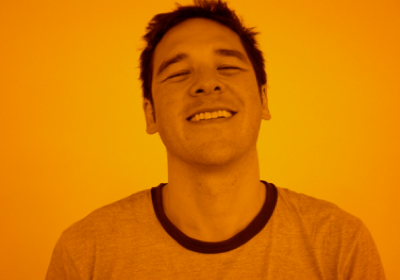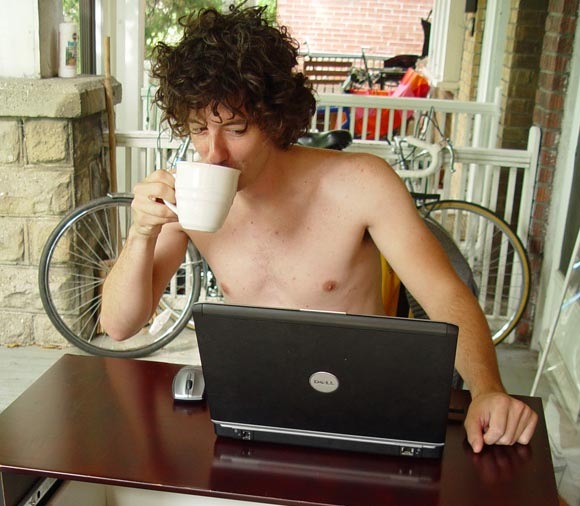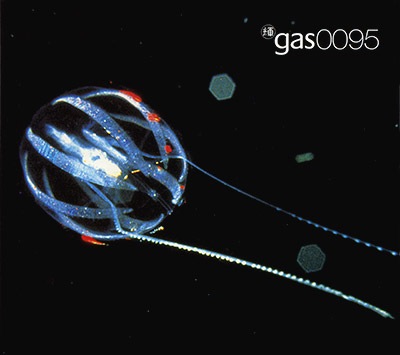Musicians and artists now have the power to fuse visuals, sound, and interaction, to make a spectacle, an album, and a game all at once. But with the blank canvas of three different media before you, what form should that fusion take?
Space shooters with pounding electronic beats behind them have cleared some of the way. Now it’s ambient music’s turn. In the game Osmos, you become a mysterious particle, floating amongst gravity wells in various fields of material. By carefully navigating, applying just the right vector force to move through the shifting landscape, you merge with other particles and escape to safety.
http://www.hemispheregames.com/osmos/
The move from “shoot stuff” to “move” or “eat” seems to be rising in popularity, with games like fl0w and Spore’s initial “cell stage” encouraging nonviolent navigation. To me, there’s something happening to the zeitgeist, perhaps a renewed awareness of cosmic (micro- or macroscopic) being, and of movement that draws on free-floating physics.
Even amongst a wave of games in this mode,when you actually play Osmos, you realize that it is something different and special. The design makes ingenious use of different kinds of movement and pacing through its different modes, at one point calling upon you to hurtle around a black hole, then move at nearly imperceptible speeds through a seemingly impossible-to-traverse petri dish of massive particles. No less than a shooter, it connects to the id and survival instinct. Pac-Man, the most successful arcarde game of all time, and one of the few that sucked in men and women in equal measure, was noted for its emphasis on eating as the mechanic. Consuming stuff appeals to everyone.
Of course, this is on a music site, and with good reason: what makes Osmos work is that Osmos is musical. It’s immediately beautiful and delicate, a perfect aesthetic union of the texture of the music and the on-screen arrangements of particles. More importantly, the music is woven directly into game play, providing subtle cues for dangers, and underscoring the pace of gameplay. You can only solve a level by managing speed and motion, and the music helps provide both the literal indications of speed and help your head get into the right zone to lose yourself in the world. If blips in early arcade games helped create a zone of play trance, now we have spectacular ambient soundtrack of music by Loscil, Gas/High Skies [Microscopics], Julien Neto, and Biosphere.
The music isn’t simply a beautiful soundtrack to the game. The game really feels like an extension of the world of the music. Put it all together, and something magical happens in this $10 game: you hear the music in a new way.
I spoke to the lead designer behind the game, programmer/animator Eddy Boxerman, along with musical-sonic collaborator Mat Jarvis aka Gas aka High Skies.
Peter: I found it amusing that some of the game press have stumbled around looking for a name for a new genre here, the "eat other stuff" category. To me, the basic game controls could be traced back to early titles like Asteroids. What are the games that have inspired you, either specifically or generally?
Eddy: Some people are dubbing the gameplay type as "eat ’em up", as opposed to the classic "shoot ’em up". But it’s true, the physics/controls have more in common with classic games such as Asteroids and Gravitar. The only "modern" game that otherwise influenced me was Katamari Damacy. It’s funny: when I sent out the first prototype to friends, I was concerned they would think the game was too similar to Katamari. That’s when I heard about flOw, which I’ve tried to steer stylistically clear of ever since. I guess it’s an archetype though, and the comparisons have been inevitable. As for Spore, Osmos was about one year into development when I saw the first preview footage of its "cell stage". On top of that, I learned that Will Wright had hired Brian Eno to do the music! I definitely had a "why should I bother?" moment at that point. But here we are, a couple years later, and I think we’ve managed to put out a unique game with a great mix of gameplay, sound, and visuals.
Peter: Ha – well, I’m glad you “bothered”! One thing that I think is really unique about Osmos is the gravitational mechanic. How did this come about?
Eddy: I was (and probably still am) a sci-fi kid. And when I read about real phenomena like colliding galaxies, retrograde planets, and the like, my mind goes to stange and wonderful places. That said, the Spacecraft Dynamics course I took during my engineering degree definitely played a large part in putting those mechanics and levels together. Thanks, Professor Misra! 🙂
Peter: How are the physical mechanics of the game constructed? This is essentially two-dimensional vector math, yes? Were there refinements you needed to make in order to keep performance up, or to keep the levels playable?
Eddy: That’s a big question! But yes, essentially it’s 2D vector math, though we make use of some 3D math (including quaternions) on the particle systems. The majority of the physics is quite simple though — first year bachelor’s stuff: F = ma, conservation of mass and momentum, gravitational laws, basic time integration, etc. We follow the spirit of the laws, but not always the letter. For instance, if you look at the Earth’s solar system in its entirety, you wouldn’t even see most of the planets; that doesn’t make for a very playable game though. As such, we took many liberties when it comes to scale, constants and exponents in the equations. The majority of the work was in the tweaking of those values to make the game /feel /good.
Peter: How did you prototype the game? What was the process of evolution like? Were there any failed attempts along the way?
Eddy: I put together the first prototype starting from a NeHe OpenGL tutorial. I added some basic physics, mouse controls, some highly unoptimised collision detection code, and voila, I had something to play with. After that, I immediately integrated [cross-platform 3D audio API] OpenAL, as the game was just begging for sound and music. I then hunted for some good sounds (discovering freesound.org in the process), put together a simple looping song (my first rough and humbling attempt to create digital music), and sent it out to a few friends. I’ll make that version available for free someday… when I’m feeling brave.
As for failed attempts, there were tons of shelved experiments and features that were cut. One interesting problem was the difficulty curve of the gravitational levels. In fact, the first gravity levels looked a great deal like the "Warped Chaos" levels do today: several free-floating Attractors in a sea of regular motes. I found it incredibly difficult, however, to make a "beginner" version of those levels. If the gravity was too weak, the Attractors had little apparent effect; too strong, and the level became incredibly difficult. I stuggled with this for a long time, until I hit on the idea of putting one, immobile Attractor in the center, with everything else orbiting around it. This allowed for the creation of systems with strong gravity effects, but long-term stability. It seems so obvious now, especially given the example of our solar system, but it wasn’t back then. In the end, these are some of the coolest levels in Osmos — practically its "signature" level type. Moral of the story: necessity really is the mother of invention.
Peter: What is the visual engine like? The sound engine?
Eddy: As I mentioned, I bootstrapped from a NeHe tutorial, but that’s all been replaced at this point. It’s now a homegrown engine using OpenGL. It doesn’t make any use of pixel/vertex shaders, so it runs on a wide variety of hardware. The majority of our texture work is done in Photoshop.
[The sound engine is] a wrapper we’ve built around OpenAL. At a basic level, all we ever do is mix and adjust the gain and pitch of our sounds and music. This allows us to run on generic sound hardware. But we do make extensive use of those "effects", and it’s possible to get a great deal of variety and feedback with them. In the end, it’s all about the quality of our sound sources, and the algorithms that adjust and smooth the gain and pitch of each.
Peter: For pitch shifting, were you able to do that natively in OpenAL?
Eddy: Yes, OpenAL supports pitch shifting at the software level. I ported our sound engine to use DirectSound at one point, and found that it’s pitch shift range is rather limited. We reverted back to OpenAL.
Peter: One thing that really strikes me about the game that is its use of pacing. Even without the obvious technique of allowing the user to control speed, there’s this extraordinary contrast between levels that require you to move quickly, that require you to anticipate the rate of movement along a vector of other objects, or that require you to move almost imperceptibly slowly. Was this an early goal, or something that evolved out of developing the game concepts?
Eddy: It evolved from the game concepts themselves. We tried to fully explore the fundamental controls and game space of Osmos, and converged on a number of interesting regions and structures that were fun to play with/in. Some people actually "complain" that the pacing of the game isn’t consistent across levels — some are fast, some slow — but that wasn’t our goal. In a sense, we’re merely presenting the results of a great deal of research and exploration into the space, with our sole requirement being that the levels are fun and interesting. We wanted it to be a game of concepts and understanding, not speed. The addition of time-warping allowed us to break free from that, expand our scope, and include a much larger variety of levels, as some have both fast and slow moments in them; we wanted the player to be able to control the pace and difficulty to their level of comfort.
Peter: Connecting the action to music, how important is the use of music in conveying time?
Eddy: I think pitch-shifting the music and sound effects helps players track time-warping in an inutitive way. Without these aural cues, the mental connection would be incomplete. That said, I sometimes test the game without sound, and it’s totally playable — just much less immersive.
Peter: At what stage did you involve the musical element? How was that relationship established?
Mat: Eddy first contacted me two or three years ago about using one of my tracks on Osmos (“Gas – Discovery”). He sent me a basic alpha version where the game was literally flat circles on a plain background, but even back then with the simple graphics and no sound it was compelling. I think it was at this early stage that I sent him a copy of another High Skies track, “The Shape of Things to Come,” which he also used a section from. It wasn’t too long later that he sent me a version of Osmos with most of the music that made it to the release version and it all just complimented each other beautifully.
Eddy has done a great job choosing music that compliments the game and graphics, and they also compliment the music. I think he’s done a great job overall as well, keeping his vision consistent for the look and feel of the Osmos world. Even though some of the levels are quite varied; some are quite chilled, others fast paced, nothing seems out of place. He has created a new world that’s both microscopic and macroscopic.
Peter: The musical and sound effect elements really do blend effortlessly. Mat, I know you made substitute sounds – how did this help blend the aesthetic?
Mat: I made the rebound noise when you bounce off the walls/ boundary. The original sound was quite hard and metallic with a lot of reverb, and I suggested a softer echoey sound. There was nothing wrong with the original, but it made the boundary feel quite hard and cold like being in a metal tank. I sent Eddy some analogue samples, using a [vintage Roland keyboard] Jupiter 6 with varying delays/ echoes. Because the tones are so pure and tuned, Eddy pitched them slightly to fit with the various keys of the different music.
Eddy: In general, it was a matter of searching and experimentation for the "right" set of sounds that fit well together — which can be a lengthy but rewarding process. Once integrated, minor gain and pitch adjustments helped fit it all together.
Mat provided the bounce sound, as well as the continuous absorb/being-absorbed sounds. The other sounds were created/shared on freesound by the users Elektrocell, fran_ky and Jovica. (Check out the Osmos credits in the readme.html for details.)
Peter: I recently spoke to Crystal Method, and while they’ve done some notable game scores, they actually said they wouldn’t want their music to be placed in a game context at which the speed changed, that it’d lose something. This seems like the opposite of that. Now, maybe it’s easy to take for granted with ambient music as opposed to something beat-driven like Crystal Method, but do you think there’s something special that allows this music to be adaptive in that way?
Mat: I think that in the right circumstances music with drums could work well and may even highlight the time-shifting more. Of course with the wrong game and wrong music it could sound terrible too.
Eddy: It’s a delicate issue. Out of the context of the game, I think it would seem wrong. There were also some pieces of music I tried which didn’t lend themselves well to this kind of manipulation, and which didn’t get included as a result. But with these songs, and everything working together in-game, I feel the whole experience is stronger as a result. I’m just glad Mat and the other artists agreed — or at least… didn’t object. 😉
Peter: Hey, I think if you can write music that sounds good played at a different speed, that’s nice.
Osmos seems to me a musical experience, in that the sense of the music is transformed by the visuals and the interaction with them. Do you think it’s possible that audiovisual interfaces could go even further in terms of their impact on the music?
Mat: Yes, it almost seems as though Osmos creates a world for the music to exist.
I’ve always liked music visualisers like the Processing and Cymatics stuff, they’re quite compelling to watch how they react to the music, so it would be interesting to go the other way; by manipulating/ sculpting abstract shapes which then modify or even create sounds and music, especially using the new controllers like the Wii, [Microsoft’s] Project Natal and Sony’s Motion Controller instead of the mouse.
Eddy: I totally agree with Mat. Yes, please! More feedback between music, visuals and interactivity — in all directions. I’d love to experiment more on all of these fronts. In general, I think games such as Audiosurf and Auditorium, while great, have only begun to scratch the surface of what’s possible. Interactive musical "toys" such as [Nintendo/Toshio Iwai’s ]ElectroPlankton or Dub Selector are another great direction; and Rock Band Network is about to expand the market in a huge way. It’s exciting!
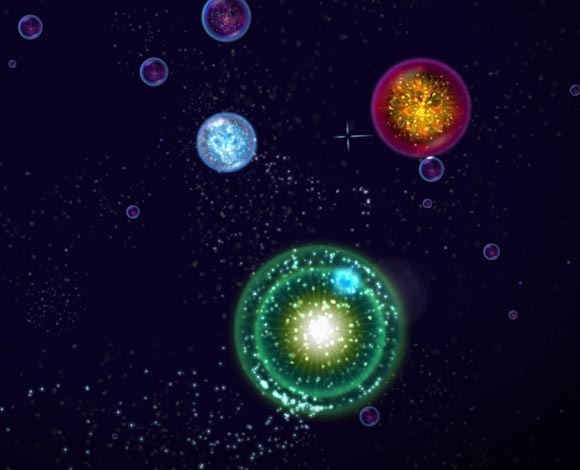 Peter: Along those lines, this is obviously a new take on music distribution in a way that goes well beyond what titles like Rock Band have done. Are there other cases in game history that to you have done that? Is there potential in these new outlets, outlets that are more accessible to independent developers (Steam, Direct2Drive, Xbox Live Arcade, iTunes App Store), to really change game development?
Peter: Along those lines, this is obviously a new take on music distribution in a way that goes well beyond what titles like Rock Band have done. Are there other cases in game history that to you have done that? Is there potential in these new outlets, outlets that are more accessible to independent developers (Steam, Direct2Drive, Xbox Live Arcade, iTunes App Store), to really change game development?
Eddy: Wow, that’s another big question. Really, I just felt the music was such an important part of the experience in Osmos that we should show the artist and track names during the game. But now that you mention it, I can’t think of another game that has done this, besides games like Rock Band where the song /is/ the game/level. That said, one way I’d love to push this evolution is to "augment" music videos with interactivity: ie. into music video-games. (The term "game" could be used rather loosely here.) Everyday Shooter does this, though Jon Mak actually created the music /for/ the game in that case — which rocks — but collaborations could lead to some really amazing things in this direction.
Peter: Eddy, Mat, thank you. Whether it’s in the form of a game or an audiovisual performance, we’ll certainly continue to explore these areas. And – hint, hint – Osmos 2, with multiplayer? Just a thought.
Osmos Trailer from hemisphere games on Vimeo.
